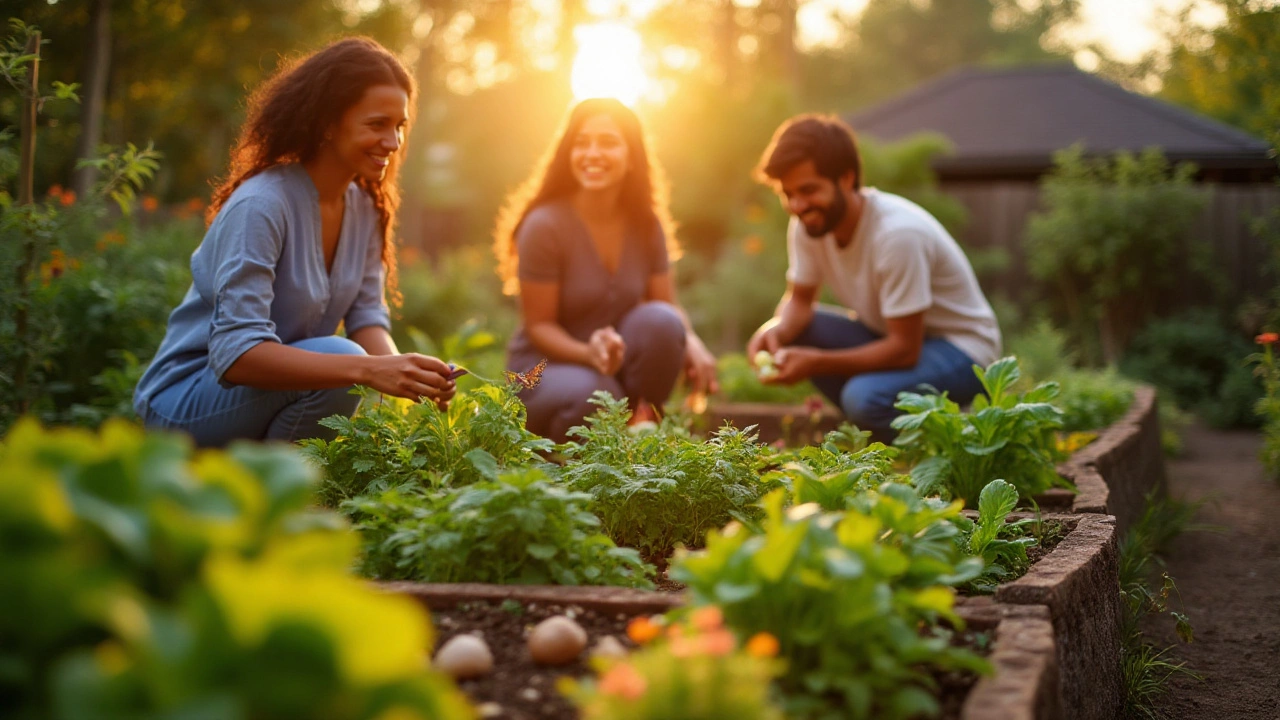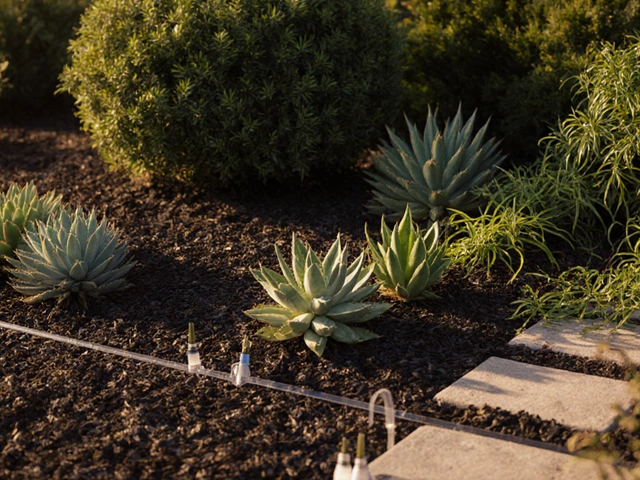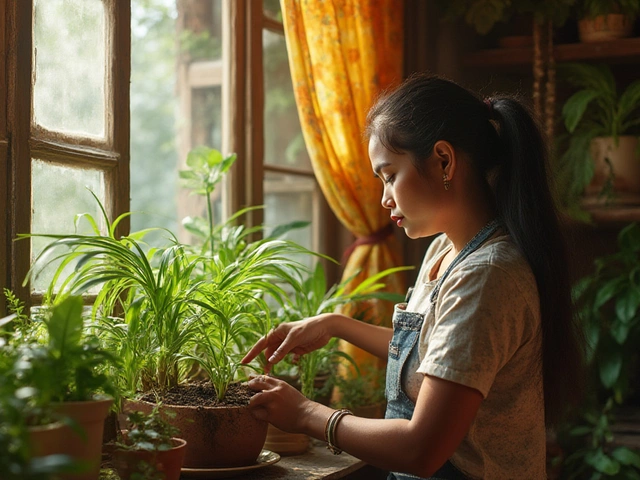Imagine stepping out to your garden and picking fresh herbs or vegetables for tonight's dinner. A kitchen garden not only makes this possible but also enriches life with simple pleasures. Planting one is an art and a science, and it threads creativity and practicality through its practice.
Whether you're planting in a tiny backyard, on a patio, or creating a kitchen garden masterpiece in a generous plot, there are endless possibilities. The aim is to grow plants that fit your lifestyle and culinary cravings, providing fresh produce whenever you need it.
Let's dig into this delightful hobby, and explore the joys and intricacies of setting up your own kitchen haven. Uncover tips and tricks to help your plants thrive and discover how this venture can turn into a cherished family activity. From planning the location to harvesting your crops, every step is a rewarding journey into self-sufficiency and healthy living.
- Choosing the Right Location
- Selecting Your Plants
- Soil Preparation and Maintenance
- Planting Techniques and Care
- Harvesting and Enjoying Your Produce
Choosing the Right Location
Embarking on the adventure of creating a kitchen garden begins with the pivotal decision of choosing the perfect spot for your plants to thrive. Location isn’t just about convenience; it plays a monumental role in your garden’s success right from the growth spurt of a tiny seedling to the fruition of a delectable vegetable. You don’t need vast expanses of land to grow your own greens. Even a balcony or a sunny windowsill can be the ideal launchpad for fresh produce if you maximize the potential of the available space.
One cannot ignore the universal need of plants: sunlight. Most vegetables require a minimum of six to eight hours of direct sunlight daily to grow properly. Assess your location's sun exposure carefully throughout the day. Watch how the sunlight moves across your potential garden space. Some plants like tomatoes and peppers love basking in the sun, thriving in its warmth, while leafy greens like spinach might tolerate partially shaded areas.
Pay attention to accessibility, as it's crucial to usability and maintenance. The closer your garden is to your kitchen, the more likely you are to stroll out and snip herbs or harvest a handful of beans, adding a fresh punch to your evening meal. Access to clean water is another crucial factor. Install a nearby rain barrel or use drip irrigation systems to ensure plants are well-watered without excessive effort.
Soil drainage is a detail often overlooked, though it can have a significant impact on plant health. Plants despise "wet feet", which is the condition when soil remains soggy or overly damp, leading to root rot. Check the drainage by digging a small hole and filling it with water. If the water doesn’t drain within a few minutes, you might need raised beds or plant containers with sufficient drainage holes.
Eliot Coleman, an expert on organic farming, once said, "Growing your own food is like printing your own money." This principle highlights the invaluable satisfaction of savoring homegrown produce, a luxury anyone can achieve with the right conditions and dedication.
Additionally, consider the opportunity a location offers for expansion. If you’re starting small, allow some room for growth. As you gain confidence, you might wish to introduce new varieties or increase your planting scale. Also, bear in mind the microclimates that vary even within small areas. This includes chilly corners, wind-prone spots, or areas shielded by walls or fences, influencing the choice of plants best suited for each micro-environment.
Finally, engage with the community around you. Speak with neighbors or the local nursery to align location selection with direct advice from those who have experienced the climatic conditions year-round. This personalized insight compliments metrics and facts, offering practical, hands-on advice that no guidebook could fully replicate.
Selecting Your Plants
When diving into the blissful journey of creating a kitchen garden, choosing the right plants is paramount. Whether you're keen to cultivate tomatoes or unleash the aromatic splendor of rosemary, the first step demands a blend of personal culinary goals and an understanding of your garden’s capabilities. It’s a unique dance between your desire for fresh ingredients and the environment's capacity to support them. Consider your climate zone and seasonal limitations. There are hardy plants that battle through cold temperatures while others bask in endless sunshine, thriving when the warmth is plentiful. Dedicating time to research these characteristics will save you future heartaches of disillusioned dreams. Don't forget to ponder about space requirements; some plants need ample room to flourish, while others are content in snug quarters, growing tidy and compact.
Determining plant types also often hinges on your family's preferences. If your household is filled with potent tomato enthusiasts, maybe a few different varieties will fill the baskets. Leafy greens like lettuce and spinach are fantastic for consistent harvests, providing leaves consistently throughout their growing seasons. Herbs, such as basil, parsley, or thyme, are also excellent choices, offering a consistent supply with culinary benefits beyond measure. A
noted expert once shared, 'Growing what you eat is the magic of gardening, turning simple meals into feasts.' Keep that in mind as you plan for fun and functional home gardening.It's equally wise to incorporate plant companions – a proven strategy known as companion planting. This approach pairs plants that benefit each other by improving growth or warding off pests. For example, pairing carrots with onions can deter certain insects that prey on them individually. On the contrary, some pairs are best avoided, as they hinder one another. Understanding these relationships can enhance your vegetable patch like an unseen harmony humming between roots.
Another crucial aspect in selecting your plants is considering the soil type in your garden patch. Is it clay-heavy, sandy, or rich in loam? Certain plants thrive in specific soil types, tapping into their core attributes for optimal growth. Should your soil not be perfect, amendments are always possible, allowing the earth to be a living cache adaptable to your needs. Additionally, make sure to account for your garden's access to light. Sun-loving plants like peppers require direct sunlight for at least six to eight hours a day to flourish, while shady corners might be better for lettuce or chives. If your space is limited or if you face less than ideal lighting, exploring vertical gardening techniques or container gardens can prove revolutionary, turning even the smallest balcony into a lush oasis.
Consider infusing your garden with lifecycles as well. A well-planned garden boasts a mix of perennial and annual plants. Perennials, once planted, will return year after year with minimal intervention, providing long-term rewards. Annuals, on the other hand, bring vibrant diversity, their lifecycle lasting a single season, offering opportunities to experiment and refresh the garden with each planting cycle. Incorporating biodiversity in plant selection not only sustains interest but also supports soil health. Rotating crops prevents nutrient depletion and disrupts pest cycles without chemicals. This is a practice known as crop rotation, an age-old agrarian tradition reimagined for the home gardener.
Data also suggests that cultivating your own produce can reduce family grocery bills significantly while contributing positively to the environment. Consider establishing a year-round harvesting strategy by selecting early, mid, and late-season varieties of the same plant. For instance, with strawberries, you may plant some that produce fruit early in spring, others that provide a bountiful harvest in mid-summer, creating an extended season of savory delight at your fingertips. This approach ensures your excitement and enjoyment from your grow your own project never fades. The plant selection phase is all about blending these elements strategically with a sprinkle of personal taste, a dollop of imagination, and a dash of patience, transforming a simple plot into your dream garden.

Soil Preparation and Maintenance
Preparing your soil is like setting the stage for a play, where your plants are the main characters ready to flourish. The heart of a flourishing kitchen garden rests in its soil. Good soil is full of life, providing the essential nutrients plants need to grow strong and yield a bountiful harvest. Before planting, assess the soil's texture and fertility. It's important to understand its composition—whether it is sandy, clay, or loamy. Each type affects water drainage and retention. For example, sandy soil drains quickly but struggles to retain moisture, while clay can hold water but often too much, leading to root rot. Consequently, loamy soil is often considered ideal, as it retains moisture while still allowing proper drainage.
To improve your soil, you might want to add organic matter, which is like giving your plants a rich feast. Compost, rotted manure, and leaf mold are excellent choices that provide a slow-release source of nutrients. Organic matter also fosters beneficial microorganisms, which promote a healthy, balanced ecosystem in your soil. Test your soil's pH before planting, aiming for a level between 6 and 7, which is best suited for most vegetables. If your soil is too acidic or alkaline, amending it with lime or sulfur can help bring it closer to the desired neutral range.
"Healthy soil is the foundation of a successful garden. Take care of it, and it will take care of your plants," says renowned horticulturist, Monty Don.
Once planted, maintenance transforms into a regular and rewarding exercise. Monitoring moisture levels is crucial, especially during hot spells, when your vegetable patch might need watering more often. Mulching around plants serves dual purposes; it reduces weeds and helps maintain soil temperature and moisture. Choose organic mulches such as straw or wood chips to keep things eco-friendly. While nutrient-rich soil encourages growth, it’s also vital to keep an eye on pest levels. Natural methods like introducing beneficial insects, such as ladybugs, or using companion planting strategies can help control pests without chemical interventions.
At times, even a thriving garden might need an added nutrient boost. Knowing when and what fertilizers to use is key. Organic fertilizers like bone meal or fish emulsion can be added midseason to keep the garden producing vigorously. However, be careful not to over-fertilize, as this could lead to excessive foliage growth at the expense of fruit and can cause nutrient imbalances. Regularly rotating your crops can help prevent the depletion of specific nutrients from the soil. Companion planting also plays an integral role, as certain plants can mutually benefit one another when grown in proximity, enhancing nutrient uptake and pest resistance.
In addition to understanding your soil's needs, keeping track of your progress with a simple gardening journal can be tremendously beneficial. It allows you to record observations on soil behavior, changes over time, and responses to different amendments and planting techniques. Over the course of the seasons, this growing insight will guide you to make improvements, bringing you one step closer to mastering the art of maintaining a home gardening system right in your backyard.
Planting Techniques and Care
Establishing your kitchen garden is like crafting a living masterpiece in your home. To begin, having the right planting techniques and dedication to daily care becomes the foundation for success. Whether you're layering rich soil into a potted herb planter, creating a vegetable patch in your yard, or cultivating a vibrant tomato vine that reaches for the sun, the basics start with understanding your plants' needs. Factors such as sunlight, space, and water requirements vary significantly between species; but no matter your selection, consistency in care truly matters. Regularly check on your plants, ensuring they receive just the right amount of attention without smothering them with overwatering or neglecting sunlight exposure.
Let's start with an essential aspect: spacing. Plants, much like people, need their room to stretch out. Crowding can lead to competition for nutrients and sunlight, stunting your vegetable patch without even trying. Stick to recommended spacing instructions on seed packets or plant guides, and provide ample room for air circulation. This not only allows for robust growth but also prevents issues such as mold and leaf disease, which thrive in cramped quarters. Taking time with gaps between plants may seem trivial, yet it bolsters future growth like magic.
Watering is another fundamental element that can't be overstated. With most plants needing an adequate drink, watering habits should reflect weather, plant type, and environmental humidity. A rule of thumb is to keep the soil moist but not soggy, as waterlogged roots can decay. Consider installing a drip irrigation system or utilizing self-watering pots, making the process less labor-intensive and more efficient. Speaking of which, try to water in the early morning or late afternoon to reduce evaporation, allowing roots to absorb moisture efficiently.
Nutrition through fertile soil is indispensable. Aim to enrich your garden with a mix of compost and organic fertilizers, enhancing the quality of homegrown produce. Monitoring your soil's pH levels comes into play, balancing acidity levels can dramatically impact plant health. Rotate crops each season, if space permits, to prevent soil depletion and pest buildup. It's a natural dance that mimics nature's rhythms, fostering an environment where plants thrive year-round.
Ever heard of companion planting? This traditional technique brings harmony into your space by pairing plants that benefit each other. When one, like basil, drives away pests, the other, such as tomatoes, can grow untroubled. It’s an age-old gardener's secret, supporting a diverse ecosystem right in your garden. "Gardening is the purest of human pleasures," once said Francis Bacon about this interconnectedness. What wisdom in letting nature's design guide your plant placements!
Finally, don't underestimate the power of vigilant care. Regularly remove weeds, deadhead flowers, and prune errant branches. These small acts promote healthier growth, as well as leaving plants visually appealing. Employ natural remedies to tackle pests, using chili pepper spray or interplanting garlic to deter them. Embrace these quirks with curiosity, and soon you'll love tending to your garden as much as enjoying the fruits of your labor.

Harvesting and Enjoying Your Produce
The climax of your kitchen garden journey is here—harvesting. This stage brings the joy of witnessing your hard work transform into fresh, edible bounty. Timing your harvest just right ensures you get the best taste and nutrition. Each plant in your home gardening endeavor has its own cues signaling readiness. For instance, tomatoes are at their prime when they reach full color and detach effortlessly from the vine. Leafy greens, like spinach and lettuce, are best picked when leaves get large enough but before maturing fully, maintaining tender bites.
Harvesting isn't just about picking. It's an act of understanding nature's rhythms. Early mornings are often optimal for harvesting as the garden is cooler, preserving the crispness and hydration of your crops. Additionally, this time lessens the effect of the heat, which can sometimes alter the flavor profiles in vegetables. Excitement might tempt you to gather more than needed, but harvesting often and small keeps plants producing longer. If your kitchen garden includes herbs, remember that their poignant aroma and flavor intensify before they bloom, making this the perfect stage for cutting.
Storing Your Bountiful Harvest
Once harvested, knowing how to store your produce maximizes freshness. Not all vegetables enjoy the same conditions; therefore, understanding the unique needs of each type is crucial. Root vegetables such as carrots and beets can be kept in cool, dark places, preserving them for months. However, your harvested leafy greens prefer a refrigerator, wrapped gently to prevent wilting. Tomatoes, contrary to common practice, maintain their flavor and texture best at room temperature—never refrigerate them.
Beyond storage, aim to incorporate your fresh produce into daily meals promptly. The nutrient retention is highest right after picking, and the flavor is unmatched. The satisfaction isn't only in eating but also in the shared experiences and health benefits that come with it. Engaging children in selecting and preparing meals is a rewarding way to teach them about healthy eating and the origins of their food. "The garden suggests there might be a place where we can meet nature halfway," Michael Pollan's words remind us of the simple joys and profound connections gardens foster.
Enjoying the Freshness
Bringing fruits of your labor to the table is truly rewarding. As you incorporate these fresh ingredients into your kitchen, the flavors and culinary possibilities are boundless. Experiment by trying new recipes or adding twists to traditional dishes. Fresh vegetables and herbs from your garden can transform simple meals into gourmet delights, pushing you to discover a new appreciation for food. From homemade sauces and pestos to fresh salads and garnishes, each dish is filled with love and effort.
Your garden's produce ensures a supply of healthy, nutritious food. More than just a source of physical sustenance, it fuels your spirit. Sharing these meals with friends and family turns cultivation into community, allowing not only flavors but stories to be shared at your dining table. By harvesting and enjoying what you've grown, you take a step towards a sustainable lifestyle and an aspiration many are leaning toward as the future unfolds.





